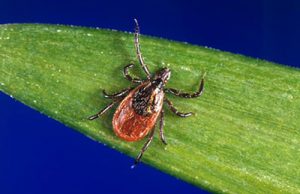 Powassan (POW) virus is transmitted to humans by infected ticks. Approximately 75 cases of POW virus disease were reported in the United States over the past 10 years. Most cases have occurred in the Northeast and Great Lakes region. Signs and symptoms of infection can include fever, headache, vomiting, weakness, confusion, seizures, and memory loss. Long-term neurologic problems may occur. There is no specific treatment, but people with severe POW virus illnesses often need to be hospitalized to receive respiratory support, intravenous fluids, or medications to reduce swelling in the brain.
Powassan (POW) virus is transmitted to humans by infected ticks. Approximately 75 cases of POW virus disease were reported in the United States over the past 10 years. Most cases have occurred in the Northeast and Great Lakes region. Signs and symptoms of infection can include fever, headache, vomiting, weakness, confusion, seizures, and memory loss. Long-term neurologic problems may occur. There is no specific treatment, but people with severe POW virus illnesses often need to be hospitalized to receive respiratory support, intravenous fluids, or medications to reduce swelling in the brain.
You can reduce your risk of being infected with POW virus by using tick repellents, wearing long sleeves and pants, avoiding bushy and wooded areas, and doing thorough tick checks after spending time outdoors. If you think you or a family member may have POW virus disease, it is important to consult your healthcare provider.
Powassan (POW) virus disease is a rare, but often serious disease that is caused by a virus spread by infected ticks. Approximately 75 cases of POW virus disease were reported in the United States over the past 10 years. POW virus is one of a group of arthropod-borne viruses (arboviruses) that can cause inflammation of the brain (encephalitis).
How do people get infected with Powassan virus?
POW virus is transmitted by the bite of an infected tick. POW virus is not transmitted directly from person-to-person.
Where and when have most cases of Powassan virus disease occurred?
Most cases have occurred in the northeastern and Great Lakes regions of the United States during the late spring, early summer, and mid-fall when ticks are most active.
Who is at risk for infection with Powassan virus?
Anyone bitten by a tick in an area where the virus is commonly found can get infected with POW virus. The risk is highest for people who live, work or recreate in brushy or wooded areas, because of greater exposure to potentially infected ticks.
How soon do people get sick after getting bitten by an infected tick?
The incubation period (time from tick bite to onset of illness) ranges from one week to one month.
What are the symptoms of Powassan virus disease?
Many people who become infected with POW virus do not develop any symptoms. POW virus can cause encephalitis (inflammation of the brain) and meningitis (inflammation of the membranes that surround the brain and spinal cord). Symptoms can include fever, headache, vomiting, weakness, confusion, loss of coordination, speech difficulties, and seizures.
How is Powassan virus disease diagnosed?
Diagnosis is based on a combination of signs and symptoms and laboratory tests of blood or spinal fluid. These tests typically detect antibodies that the immune system makes against the viral infection.
What is the treatment for Powassan virus disease?
There is no specific medicine to cure or treat POW virus disease. Treatment for severe illnesses may include hospitalization, respiratory support, and intravenous fluids.
How can I reduce the chance of getting infected with Powassan virus?
The best way to prevent POW virus disease is by protecting yourself from tick bites. There is no vaccine against POW virus.
- Avoid contact with ticks by avoiding wooded and bushy areas with high grass.
- Apply insect repellents to bare skin, according to label instructions.
- Repellents containing DEET can be applied to exposed skin, but only last a few hours.
- Clothing and gear can be treated with permethrin, which remains protective through several washings.
- Find and remove ticks immediately before they have a chance to bite and attach.
- Bathe or shower (preferably within 2 hours after being outdoors) to wash off and find ticks on your body.
- Conduct a full-body tick check. Parents should thoroughly check children, especially in their hair.
- Also examine clothing, gear and pets.
What should I do if I think a family member might have Powassan virus disease?
If you are concerned that someone you know might have Powassan virus disease consult a healthcare provider.



